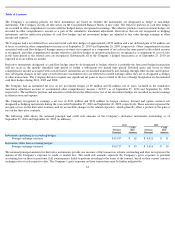Apple 2010 Annual Report Download - page 57
Download and view the complete annual report
Please find page 57 of the 2010 Apple annual report below. You can navigate through the pages in the report by either clicking on the pages listed below, or by using the keyword search tool below to find specific information within the annual report.
Table of Contents
Version 10.6 Snow Leopard (“Mac OS X Snow Leopard”),
which was released during the fourth quarter of 2009. The capitalized costs are being
amortized to cost of sales on a straight-line basis over a three year estimated useful life of the underlying technology.
Total amortization related to capitalized software development costs was $48 million, $25 million and $27 million in 2010, 2009 and 2008,
respectively.
Advertising Costs
Advertising costs are expensed as incurred. Advertising expense was $691 million, $501 million and $486 million for 2010, 2009 and 2008,
respectively.
Stock-Based Compensation
The Company accounts for stock-
based payment transactions in which the Company receives employee services in exchange for (a) equity
instruments of the enterprise or (b) liabilities that are based on the fair value of the enterprise’
s equity instruments or that may be settled by the
issuance of such equity instruments. Stock-based compensation cost for restricted stock units (“RSUs”)
is measured based on the closing fair
market value of the Company’s common stock on the date of grant. Stock-
based compensation cost for stock options is estimated at the grant
date based on each option’s fair-value as calculated by the Black-Scholes-Merton (“BSM”) option-
pricing model. The Company recognizes
stock-based compensation cost as expense ratably on a straight-
line basis over the requisite service period. The Company will recognize a benefit
from stock-
based compensation in equity if an incremental tax benefit is realized by following the ordering provisions of the tax law. In addition,
the Company accounts for the indirect effects of stock-
based compensation on the research tax credit, the foreign tax credit and the domestic
manufacturing deduction through the income statement. Further information regarding stock-
based compensation can be found in Note 7,
“Shareholders’ Equity and Stock-Based Compensation” of this Form 10-K.
Income Taxes
The provision for income taxes is computed using the asset and liability method, under which deferred tax assets and liabilities are recognized
for the expected future tax consequences of temporary differences between the financial reporting and tax bases of assets and liabilities, and for
operating losses and tax credit carryforwards. Deferred tax assets and liabilities are measured using the currently enacted tax rates that apply to
taxable income in effect for the years in which those tax assets are expected to be realized or settled. The Company records a valuation
allowance to reduce deferred tax assets to the amount that is believed more likely than not to be realized.
The Company recognizes the tax benefit from an uncertain tax position only if it is more likely than not the tax position will be sustained on
examination by the taxing authorities, based on the technical merits of the position. The tax benefits recognized in the financial statements from
such positions are then measured based on the largest benefit that has a greater than 50% likelihood of being realized upon settlement. See Note
6, “Income Taxes” of this Form 10-K for additional information.
Earnings Per Common Share
Basic earnings per common share is computed by dividing income available to common shareholders by the weighted-
average number of shares
of common stock outstanding during the period. Diluted earnings per common share is computed by dividing income available to common
shareholders by the weighted-
average number of shares of common stock outstanding during the period increased to include the number of
additional shares of common stock that would have been outstanding if the potentially dilutive securities had been issued.
54
























